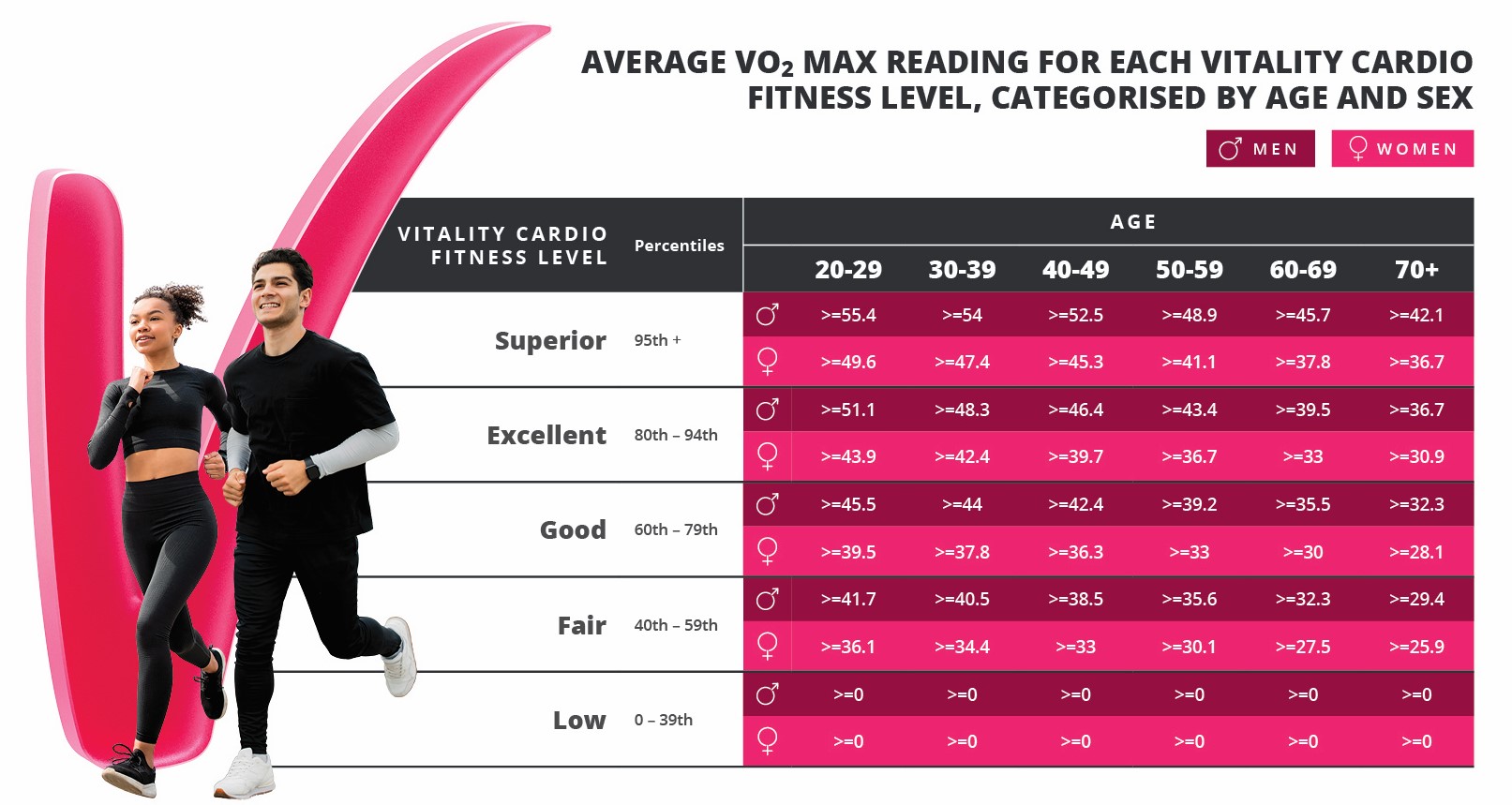Vitality Cardio Fitness Levels
Understand this powerful predictor of fitness and health, learn how to track and improve your VO2 max to get fitter, plus earn up to 10,000 Vitality points for your Vitality Cardio Fitness Level.
Understand this powerful predictor of fitness and health, learn how to track and improve your VO2 max to get fitter, plus earn up to 10,000 Vitality points for your Vitality Cardio Fitness Level.
Watch one of the below fitness device videos to find out how to measure your VO2 max by doing a qualifying walk, run or cycle.
Apple Garmin Samsungand other devices coming soon.
To earn Vitality points, make sure your fitness device and its app are linked to Vitality. If your fitness device is already linked to Vitality your results will be automatically shared with us for your Vitality points allocation.
A biokineticist can measure your VO2 max through a submaximal effort test, where you'll walk or cycle indoors until a particular heart rate or effort level is reached.
If you're 18 or older, you can book a Vitality Fitness Assessment with a biokineticist registered on the Vitality Wellness Network.
Find a partner biokineticist Visit a Discovery StoreYou can earn up to 10,000 Vitality points depending on your Vitality Cardio Fitness Level, and we use your VO2 max readings to calculate your Vitality Cardio Fitness Level. Your VO2 max reading depends on many different factors, including age, sex, genetics, fitness level and health conditions. This means there is no 'one size fits all' measurement.
Look at the example table below to get an idea of how we work out your Vitality Cardio Fitness Level based on your VO2 max reading:

Vitality members can earn up to 10,000 Vitality fitness points every year depending on their Vitality Cardio Fitness Level.
Vitality uses verified global norms that take your age and sex into account.
Whatever your Vitality Cardio Fitness Level, you can improve it to enjoy better health and get rewarded with Vitality. The higher your Vitality Cardio Fitness Level, the more Vitality points you'll earn.
You're working towards a fitter you, and that's terrific! Here are some tips to help you move from a less active lifestyle to building a solid foundation for good cardio fitness.
Consider your weight: If you're carrying extra weight, consistent exercise, along with a healthy balanced diet can help you lose some, and it will also make exercise easier. It may be worthwhile signing up to the Vitality Healthy Weight programme for on-demand support from a qualified dietitian, healthy eating plans and more.
Calculating your heart rate involves determining your beats per minute (bpm). Wear a heart rate monitor, which can be a chest strap or a wrist device and follow the instructions for your specific monitor to get an accurate reading.
Once you know your heart rate, you can determine your heart rate zones. These zones help tailor your exercise intensity to achieve specific fitness goals.
For example: If your estimated MHR is 180 (220 - age of 40) and you want to exercise in the moderate intensity range (70 - 80% of MHR), you'd aim for a heart rate between 126 - 142 BPM (180 * 0.7 to 180 * 0.79).
Remember, individual factors such as fitness level, medications, and health conditions can affect your heart rate. If you have concerns or specific health conditions, it's best to consult with your doctor before you start a new exercise plan.
Disclaimer
Before starting any exercise, please consult a with a healthcare professional to lower the risk of injuries. The guidance on this page is not a replacement for medical advice. Any activities you undertake based on this advice are entirely your choice and come with inherent risks. Discovery Vitality is not responsible for any injuries, damages, or health issues that may occur due to the information, products, or services obtained from this page, including workouts, training plans, or information.